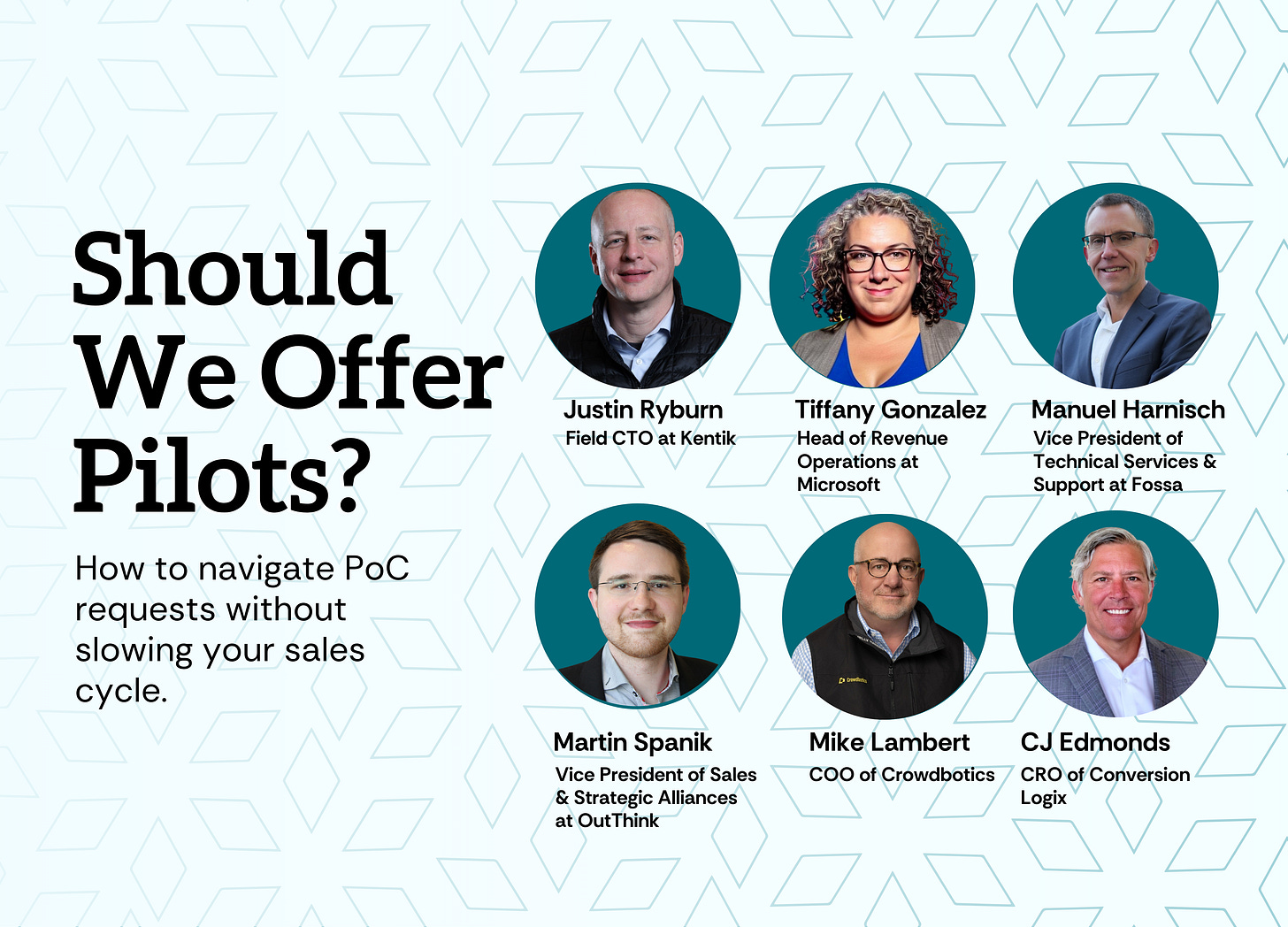DEAR STAGE 2: I had a chat with a Chief Procurement Officer of a large company recently, and he said that if a company doesn’t offer a pilot, it’s a major red flag. Curious to learn your position around pilots? ~PILOT INTRIGUED
DEAR PILOT INTRIGUED: I’ve had a few conversations recently about where pilots or proofs of concept (PoCs) fit into today’s sales process, especially in a world where AI is reshaping buying behavior, and prospects are increasingly wary of going “all-in” without testing. The reality is, some form of pilot or PoC is becoming more common, especially in enterprise sales. But that doesn’t mean it’s always the right move.
Whether a pilot is necessary, optional, or avoidable depends on several factors: product maturity, implementation complexity, and your confidence in value delivery.
To unpack this further, I turned to a few LPs in the Stage 2 community—sales leaders who’ve navigated the pilot dance from both sides—to weigh in on the trends they’re seeing.
When Does a Pilot Make Sense?
Pilots aren’t just a sales tool—they’re a buying tool. For enterprises evaluating new technology, a pilot might be seen as table stakes.
“It depends on the maturity of the product,” said Mike Lambert, COO of Crowdbotics, which is echoed by many experienced operators.
Manuel Harnisch, Vice President of Technical Services & Support at Fossa, added: “The more complex [the product implementation], the less likely you'll see a pilot, unless it's paid.”
So how do you decide?
Pilot more often when: your product is early-stage, new to market, or your buyer needs a confidence boost in the product’s value or compatibility.
Avoid pilots when: the implementation is complex, the buyer isn’t committed, or you have proven outcomes that can be backed up by case studies and references.
Define Success Criteria Early
If you do offer a pilot or PoC, expectation setting and structure is everything.
“Make sure the success criteria are clear and agreed upon before starting,” advises Justin Ryburn, Field CTO at Kentik. “Otherwise, both sides are wasting resources playing around with the product with no defined goal in place.”
This is a common misstep: early-stage teams mistake a PoC for an extended demo, rather than a tightly scoped path to conversion.
Pro tip: Define measurable goals, set a timeline, and decide in advance what a “yes” or “no” looks like at the end. Without this, a pilot is just a free trial with meetings attached.
Paid Pilots Are the Norm, Not the Exception
Unpaid PoCs often signal a lack of buyer commitment. Experienced sellers use paid pilots to ensure the buyer has skin in the game and is invested in the outcome.
CJ Edmonds, CRO of Conversion Logix, shared a tactic that’s both strategic and sticky: “We put a continuation clause in the contract. The client has the option to cancel services in 120 days. If they don’t, service continues at the new agreed-to price.”
This subtle change is easy for any company to implement, and it flips the opt-in decision to an opt-out and reduces friction during the transition to a full contract.
Pilots ≠ Product Trials
It’s important to understand the real reason a buyer is requesting a pilot. Often, it’s not about technical validation. Sometimes the buyer just wants to test if your product is "enterprise grade," not whether it technically works.
Either way, it’s essential to get to the crux of the buyer’s concerns before agreeing to the shape and duration of a pilot.
Tiffany Gonzalez, Head of Revenue Operations at Microsoft, pointed out that pilots can create additional overhead for the customer, not just the vendor: “There is often a lot of extra work for the customer…which scales costs and complexity,” she said.
Best practice: Ask a lot of questions and don’t assume the buyer’s request for a pilot is about functionality. It might be about fit, maturity, or integration readiness.
Position With Confidence
Asking a lot of questions, requiring payment, and setting success criteria early are proven tactics for making the most out of the pilot journey. But it’s important to acknowledge that there are plenty of examples of pilots slowing deals.
Certain sales leaders start from a no-PoC default and hold firm.
“My starting position has always been to avoid pilots or POCs,” said Martin Spanik, Vice President of Sales & Strategic Alliances at OutThink. “Instead, focus on demonstrating value through tailored demos, case studies, and later in the cycle, reference calls.”
Martin only shifts if the competitive pressure requires it—and even then, he insists on commitment and rigor, from senior buyer involvement to structured timelines and weekly check-ins.
As you work with your sales team to navigate the role of pilots in your process, remember that there’s no one-size-fits-all playbook. The key is being intentional—understanding the buyer’s real concerns, aligning expectations, and structuring PoCs in a way that drives urgency and mutual commitment.
Until next week!



